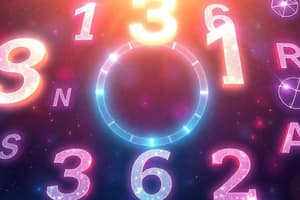Podcast
Questions and Answers
What is the least common multiple (LCM) of the integers 6 and 8?
What is the least common multiple (LCM) of the integers 6 and 8?
- 24 (correct)
- 12
- 48
- 18
What technique involves showing that a statement holds for a base case and for n implies n + 1?
What technique involves showing that a statement holds for a base case and for n implies n + 1?
- Universal quantification
- Induction (correct)
- Direct proof
- Proof by contradiction
Which of the following statements is true regarding sets?
Which of the following statements is true regarding sets?
- A - B contains elements only in B.
- A ∩ B contains all elements of A and B.
- A ∪ B is the empty set if A and B are disjoint.
- A is a subset of B if every element of A is in B. (correct)
What defines an injective function?
What defines an injective function?
Which of the following defines a surjective function?
Which of the following defines a surjective function?
What is the formula for calculating combinations of n objects taken k at a time?
What is the formula for calculating combinations of n objects taken k at a time?
According to the binomial theorem, what is the expansion of (a + b)⁴?
According to the binomial theorem, what is the expansion of (a + b)⁴?
What does the Pigeonhole Principle state?
What does the Pigeonhole Principle state?
In the context of function composition, how is the output of one function treated?
In the context of function composition, how is the output of one function treated?
Study Notes
Number Theory
- Definition: The branch of mathematics dealing with integers and their properties.
- Key Concepts:
- Prime Numbers: Natural numbers greater than 1 that have no positive divisors other than 1 and themselves.
- Divisibility: Conditions under which one integer can be divided by another without leaving a remainder.
- Greatest Common Divisor (GCD): The largest positive integer that divides two or more integers without a remainder.
- Least Common Multiple (LCM): The smallest positive integer that is divisible by two or more integers.
- Modular Arithmetic: A system of arithmetic for integers, where numbers wrap around upon reaching a certain value (the modulus).
Set Theory
- Definition: The study of sets, which are collections of objects.
- Key Concepts:
- Sets: Denoted using curly braces, e.g., A = {1, 2, 3}.
- Elements: Objects contained in a set.
- Union: A ∪ B is the set containing all elements from A and B.
- Intersection: A ∩ B is the set containing elements common to both A and B.
- Difference: A - B is the set of elements in A that are not in B.
- Subsets: A is a subset of B if all elements of A are in B.
- Power Set: The set of all subsets of a set, including the empty set.
Logic And Proofs
- Definitions:
- Propositions: Statements that are either true or false.
- Logical Connectives: AND, OR, NOT, IMPLIES, BICO-IMPLIES, used to form compound statements.
- Key Concepts:
- Truth Tables: Tables that summarize the truth values of logical expressions.
- Quantifiers:
- Universal (∀): Indicates that a statement is true for all elements in a domain.
- Existential (∃): Indicates that there is at least one element in a domain for which the statement is true.
- Proof Techniques:
- Direct Proof: Proving a statement by straightforward logical deduction.
- Contradiction: Assuming the opposite of what you want to prove and deriving a contradiction.
- Induction: Proving a base case and then showing that if it holds for n, it also holds for n+1.
Functions And Relations
- Definitions:
- Function: A relation that assigns exactly one output for each input from a set.
- Relation: A set of ordered pairs.
- Key Concepts:
- Domain: The set of all possible inputs for a function.
- Codomain: The set of all possible outputs of a function.
- Injective (One-to-One): A function where distinct inputs map to distinct outputs.
- Surjective (Onto): A function where every element of the codomain is an output for at least one input.
- Bijective: A function that is both injective and surjective.
- Composition of Functions: Combining two functions where the output of one function becomes the input of another.
Combinatorics
- Definition: The study of counting, arrangement, and combination of objects.
- Key Concepts:
- Permutations: Arrangement of objects in a specific order. Formula: n! (n factorial).
- Combinations: Selection of objects without regard to the order. Formula: C(n, k) = n! / (k!(n-k)!).
- The Counting Principle: If there are m ways to do one thing and n ways to do another, then there are m × n ways to perform both actions.
- Binomial Theorem: Describes the algebraic expansion of powers of a binomial (a + b)ⁿ.
- Pigeonhole Principle: If n items are put into m containers, with n > m, at least one container must contain more than one item.
Number Theory
- Branch of mathematics focusing on integers and their properties.
- Prime numbers are integers > 1 divisible only by 1 and themselves.
- Divisibility rules determine if one integer divides another without remainder.
- Greatest Common Divisor (GCD) is the largest integer dividing multiple integers without remainder.
- Least Common Multiple (LCM) is the smallest positive integer divisible by multiple integers.
- Modular arithmetic involves integer operations where numbers "wrap around" a modulus.
Set Theory
- Studies sets (collections of objects).
- Sets are denoted by curly braces { }, e.g., A = {1, 2, 3}. Elements are the objects within a set.
- Set operations include union (∪, all elements from A and B), intersection (∩, common elements), difference (-, elements in A but not B).
- Subsets are sets where all elements are contained within another set.
- Power set is the set of all possible subsets of a given set (including the empty set).
Logic and Proofs
- Propositions are statements that are either true or false.
- Logical connectives (AND, OR, NOT, IMPLIES, BICO-IMPLIES) combine propositions.
- Truth tables display the truth values of logical expressions based on input values.
- Quantifiers (universal ∀, existential ∃) describe the scope of a statement's truth (all elements or at least one).
- Proof techniques include direct proof, proof by contradiction, and mathematical induction.
Functions and Relations
- A function assigns exactly one output to each input from a defined set. A relation is a set of ordered pairs.
- Domain is the set of all possible inputs; codomain is the set of all possible outputs.
- Injective (one-to-one) functions map distinct inputs to distinct outputs.
- Surjective (onto) functions ensure every element in the codomain is an output.
- Bijective functions are both injective and surjective.
- Function composition involves chaining functions together.
Combinatorics
- Deals with counting, arranging, and combining objects.
- Permutations are ordered arrangements (n! factorial).
- Combinations are selections without regard to order (C(n, k) = n! / (k!(n-k)!)).
- Counting principle: m ways to do one thing and n ways to do another result in m × n ways to do both.
- Binomial theorem expands (a + b)ⁿ algebraically.
- Pigeonhole principle: If n items are placed in m containers (n > m), at least one container has more than one item.
Studying That Suits You
Use AI to generate personalized quizzes and flashcards to suit your learning preferences.
Description
Test your understanding of key concepts in number theory and set theory. This quiz covers topics such as prime numbers, divisibility, GCD, LCM, and the basics of sets and their operations. Challenge your mathematical knowledge and improve your skills!




